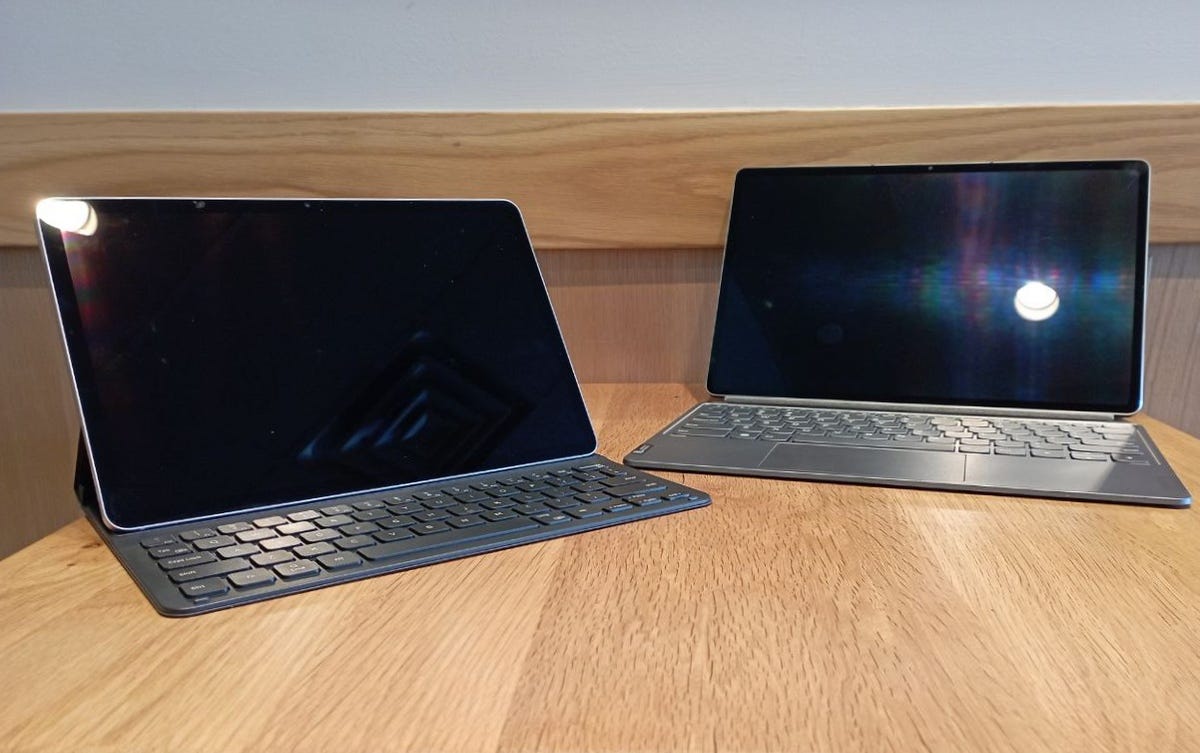
In January, I wrote about the premium Android gap the U.S. faces when it comes to smartphones. To a lesser extent, there’s also one for tablets. Xiaomi keeps its Android tablets out of the U.S. market, and TCL and Amazon focus on the value segment. Indeed, mass retailers offer a host of cheap Android tablet/keyboard combos that can cover the basics of word processing and web browsing. At the high end, though, Samsung and Lenovo are the only major U.S. market players offering a broad range of Android tablets for pros and business.
Go big but zero in
Particularly to compete against the 12.9″ iPad Pro, both Samsung and Lenovo have gone well past the popular 10″ and 11″ screen sizes. Both companies offer their most recent Pro tablets with 12″+ displays. Beyond that, Lenovo offers its Yoga Tab with a 13.3″ display while Samsung’s latest S8 is available in a whopping 14.6″ screen size, the largest Android tablet the company has made since 2019’s 17.3″ Galaxy View 2. When it comes to the Yoga Tab, offering a tablet capable of multi-modality or different poses hasn’t impacted the tablet category that similar flexibility has had on notebooks. That said, there’s nothing comparable to the design of Lenovo’s Yoga Tab line, and Samsung’s 8″ Galaxy Tab Active 3 similarly stands alone for frontline applications that invite extreme heat, cold, dust, rain, and risk of drops.
Play up security
While Samsung has long highlighted the role that its Knox security stack plays across its S-series tablets and smartphones, it’s been encouraging to see the company highlight Knox’s availability in its business-focused A-series smartphones, which may portend Knox also coming to its more affordable A-series tablets. Lenovo has been further behind in crossover security branding. However, with ThinkShield, now one of the few Lenovo-associated PC feature brands currently being featured on its Motorola handsets, it also seems bound to be featured more prominently in the mother brand’s P-series pro Android tablets.
Scribbling for success
While Samsung had a Note tablet subbrand in the early days, its S-series tablets subsumed pen functionality before it was cool. Historically, it has handled the ever-vexing problem of pen-docking better than Lenovo; with its latest tablet offerings, Lenovo has adopted Samsung’s S7 approach of docking the pen to the rear of the tablet, making for an inelegant hump, albeit a removable one that offers secure storage and can improve grip, particularly on the larger sizes.
With its S8 series keyboard folio, Samsung now offers a compromise. When using the tablet, you can keep it docked to the rear of the tablet, where it charges. But when on the go, you can stow the S Pen in the folio hinge, where it is sleek and secure but doesn’t charge. Both Lenovo’s and Samsung’s pen storage options are more secure than the exposed side-attach options that are the default pen attachment options for the Microsoft Surface and iPad. Lenovo has also added an in-screen pen button similar to the one Samsung has had on its tablets for years. Like the Samsung version, it includes options for screen capture and taking notes that can be transcribed in real-time. In addition to offering some fun features such as AR Doodle, the Samsung version is extensible, but Lenovo’s version includes a handy screen magnifying feature.
Second screen
While most Android tablets can function as second monitors with third-party software, Samsung and Lenovo have taken contrasting measures to answer Apple’s Sidecar feature, which allows the use of an iPad as a second monitor. Samsung’s approach works with Windows’ screen projection feature and is activated with just a tap of a quick settings button while Lenovo’s is based on its Project Unity effort that I wrote about last September.
While Project Unity promises to offer more flexibility down the line, it requires downloading an app today and officially supports only Lenovo PCs (although I found it worked with other PC brands). Lenovo should also offer a more direct approach as it has with its largest Yoga Tab that includes an HDMI-in connector as, for example, the Wi-Fi-based connection didn’t work within a Starbucks even though both devices were connected to the network. While neither Lenovo nor Samsung offers anything as slick as the device-boundary-blurring Universal Control feature recently unveiled by Apple, second-screen functionality adds at least $200 worth of value as an alternative to buying a secondary portable monitor, few of which include their own battery.
Desk up
One of the biggest differentiation pro-Android tablets have versus inexpensive versions, or even the iPad, has been the ability to switch into a desktop mode. Samsung has long offered this via the DeX feature on its tablets, an extension of the interface it can present when an S-series smartphone connects to a monitor or television. Lenovo’s more recent answer is Productivity Mode, which presents a more subtle change to the user interface, e.g., keeping launcher icons intact, while still presenting a taskbar
While either can be activated via a tap on the settings button and Productivity Mode’s transition is faster than DeX, most Windows users will find the DeX approach more familiar. That said, Lenovo offers an experimental feature that allows users of its desktop mode to extend work area across multiple monitors versus simple mirroring of the display, a feature that’s been historically limited to “desktop” OSes such as Windows macOS and Chrome OS.
The latest pro Android tablets bring a degree of polish and flexibility that is far beyond the early days of such devices–with more promising enhancements coming soon. But they continue to face stiff competition and category friction that I’ll explore in my next column.

























